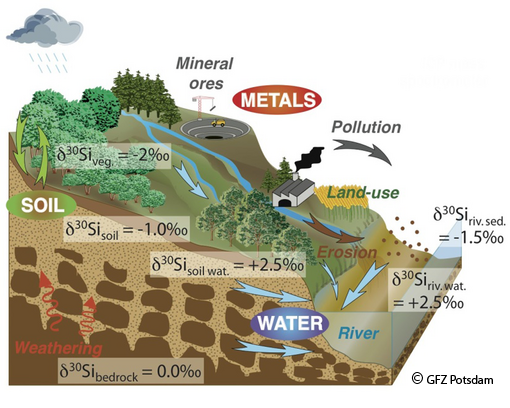"Novel" Isotope Systems Measured by Multicollector ICP-MS
The introduction of new mass spectrometers in the form of multicollector ICP-MS has provided Geochemists with the ability to detect with high precision minor shifts on the stable isotopes of the metal and metalloid elements that are induced by physico-chemical reactions. These novel stable isotope techniques will disclose the processes generating (e.g. weathering, mineral ore formation) and destroying (e.g. erosion, pollution) resources like soil, nutrients to ecosystems, and ore resources. Such fingerprints are also produced during anthropogenic processes such as ore mining, land use change, and pollution.
The yellow boxes show how the periodic table has been "colonised" by isotope Geochemists since the introduction of multicollector ICP mass spectrometry. This technique, which is at the analytical heart of IsoNose, allows to detect minor shifts in the ratio of the stable isotopes of the metals (e.g. Li, Mg, Fe, Cu, Zn, Mo, U) and the metalloids (e.g. B, Si).

The IsoNose "approach"
Soil, water, and precious metals are major natural resources present at the Earth´s terrestrial surface and their efficient management is essential for future sustainable development. Their availability is regulated by massive biogeochemical transformations that take place as the chemical elements move from rock to soil, into plants, through ground water, into river water, and into ore deposits. These precious resources are currently being exploited to an extent that is unprecedented in the history of our planet. We will make use of recent technological advances, in the form of novel mass-spectrometric methods, that have the as-yet unrealised capacity to make fundamental advances in understanding the formation of these resources. The understanding developed with these new tools will ultimately guide the sustainable exploitation of Earth surface environments. We will train young researchers in these ISOtopic tools as NOvel Sensors of Earth surface resources (IsoNose) through this European Initial Training Network. Long-term collaboration to train this new generation of scientists will be initiated by instrument manufacturers, academic specialists in method development and applications, private sector participants from the environmental, material certification, and metal ore resources fields. The researchers will use IsoNose as a platform to lead this emerging field into new areas, including the geosciences, environmental forensics, biomedical sciences, and mineral resource prospecting.

The ISONOSE (our objective is to use isotopes to "scent", like with a nose, Earth Surface resources, hence “ISONOSE”) research and training programme will focus on three major Earth surface resources: soil, water and metals. Novel stable isotope techniques will disclose the processes generating (e.g. weathering, mineral ore formation) and destroying (e.g. erosion, pollution) these resources. Shown are the isotopic fingerprints of stable silicon isotope ratios (30Si/28Si, expressed in δ 30Si-values, the per mil difference relative to an international reference material) at the Earth surface6. δ 30Si-values are higher in soil water than in bedrock because plants and clays preferentially take up the light Si isotope (28Si). These low δ 30Si -values materials are then exported as river sediment through erosion. Therefore, Si isotopes in soil- and river material fingerprint the natural processes of plant uptake and clay formation. Such fingerprints are also produced during other natural and anthropogenic processes such as ore formation, land use change, and pollution, across the array of novel stable isotope systems (Li, B, Mg, Si, Ca, Cr, Mn, Fe, Ni, Cu, Zn, Sr).


